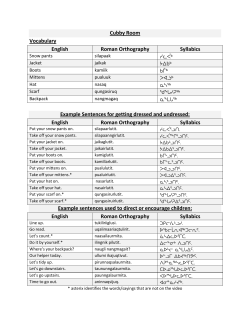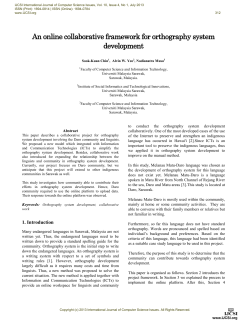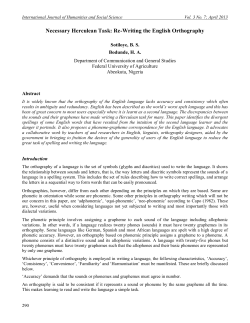
Document 508
RESEARCH REPORTS 52. NEW ORTHOGRAPHIES FOR GA AND DANGME by E.O. Apronti * This brief report covers attempts that have been made in recent months to revamp the current orthography of the Ga language and devise a fresh - and first - one for Dangme. I have served on the two committees appointed by the Ministry of Education to go into this matter and would like to discuss the progress made so far. I propose to handle the two issues in turn, since the rate of progress made in, and the perspectives of, the two committees evince significant differences: these ultimately derive from the fact that Ga has had an orthography of fairly long duration, whereas Dangme had been served by individuals' more or less idiosyncratic adaptations of Ga Orthography. We shall deal with Ga first. Ga Orthography - symbols, diacritics, spelling rules - has passed through many changes; from Dr. Lepsius's Africa Script, through Westermann's 1929 Ghana Script up to a few changes introduced in the late 1950s. When the Bible Translating Committee for Ga started working, the need was felt to regularize Ga Orthography so as both to get rid of inconsistencies in it and also to enable Ga-speakers who are literate in English to turn a little more easily to the reading of their own Ghanaian language. Two schools of thought at once emerged. There were first what we may term the "preservationists" mainly composed of members of the Ga Society. They maintained that Ga scholarship would suffer disastrously from any further tampering with Ga Orthography. It was their considered opinion that, taking- into account the number of books printed in the current orthography and the number of manuscripts ready for printing, no useful purpose would be served by any further orthographic changes. * Dr. E.O. Apronti is a Research Fellow in Linguistics. RESEARCH REPORTS 53. The other school of thought were the proponents of change; they varied considerably in how much change they were prepared to countenance. But it is still useful to consider them as one bloc since the bulk of the work done on orthography so far has been done by them, the Ga Society having, as it were, washed its hands off any project which was going to change the status quo. The Ad Hoc Committee's first terms of reference concerned a decision on whether four symbols of the current Ga Orthography should be replaced by more familiar English - based ones. The four symbols and the prospective replacements were as follows: '/' and English 'sh', ^dz' and English ' j ' , ! ts f and English 'ch1, ! g' and English 'ng!. After detailed discussion, the Committee recommended the first two changes for adoption, so that f shf replaced '/', and f j T replaced ^dz'. It was felt that these changes would also reduce printing and typing costs. In the case of the other two proposals - 'ch' for 'ts' and 'ng1 for 'q1 - the Committee decided that the adoption of these two would pose more problems than it would solve. The adoption of 'ch' for instance would have meant that this would be the only diagraph in Ga of which one member namely 'c' did not occur elsewhere in the orthography. And the adoption of 'ng' for 'g' would have resulted in some very awkward spellings since this letter often begins some words in which it is part of an initial consonant complex. "Sorrow", currently written as qkomo would have had to be spelt ngkomo; and "libation", now written as kpai would have had to be spelt ngkpai. These two changes having been agreed upon by the proponents of change, it was decided to enlarge the Ad Hoc Committee's terms' of reference and authorize it to put forward proposals for word division, RESEARCH REPORTS 54. tone marking and the orthographic representation of vowel length. The Committee has been meeting over a period of some fourteen months on these matters and has formulated some draft recommendations. Under word division, for instance, broad agreement has been reached that the following should be treated as single words: (a) Actor nouns formed from verbs, e.g. tsoolo. (b) Geographical place names unless they have already been institutionized as multi-word structures, e.g. Kweiman, Amuginaa; examples of multi-word place names are Kole Gono and Abose Qkai. (c) Titles and nicknames, e.g. Kpakpotse, Maqtsebij Ohifenane. (d) Truncated expressions involved shi as in qmoshi, nii as in niyenii, momo as in yoomo, awo as in Aateq, mil as in tsuq. (e) Words incorporating tso in its meaning of "frame" but not "tree1*, examples being saatso, gbomotso, hietso. (f) Colligation of personal pronouns and verbs as in miye, oye etc. (g) Colligation of possessive pronouns and nouns, as in mifai, ofai etc. (h) Colligations of auxiliary verbs and main verbs as in baaye, miiya etc. (i) Conjunctions such as beni, koni, keji. (j) Reduplicated adjectives and adverbs, such as basabasa, voovoo. Broad agreement has also been reached .on the separation of words in structures such as noun subject plus RESEARCH REPORTS 55. verb, e, « Kofi__tee^ verb plus object e.g. Kofi le Ado, ___mo, noun plus postposition, e.g. tso shishi, £e_^ua* verb p plus noun jj^ij, double verbs e.g. £ _^ collocations such as g.bee_slai and shigbeerno* On vowel length, the committee Is inclined to feel that length in vowels should be reflected in doubling of vowels so that "to lend" should be written fa and "river" should be faa, but felt that where ambiguity is unlikely, single vowels should be retained, as ^ n 2^^e* Ato and La, The Committee dislikes tone marking and would • like individual writers to insert as sparingly as possible those tone marks that they feel are ABSOLUTELY essential. One of the avowed aims, of the Committee was to device orthographic conventions that would be distinguished by their consistency and simplicity, rules that would be grammar-sensitive and therefore consistent with the known structure of Ga. No wonder then that controversies have been raging within the Committee as to, for instance, thf logicality of separating subject nouns from the verbs with which they colligate but joining subject pronouns to verbs in exactly identical constructions. It is true that the latter practice is used In the current Ga Orthography. But it appears to derive from Akan practice, where, of course* it is justifiable • on the bases of regular phonological relationships that can be established between the pronouns and nouns concerned. The question is whether such an in-built irregularity of orthographic convention is going to endear itself to the reader and writer of Ga. Work is progressing in this Committee where .pressure .of time in the Bible Translation Committee'1 is leading to a quick decision on what to recommend. Turning to the hew Dangme Orthography, the situation is somewhat different. This language had RESEARCH REPORTS 56. erroneously been lumped together with Ga for a long time, but it^s separate identity was established in the early 50s when Professor Berry and others turned the searchlight on it. Some publications have appeared in Dangme, for which adaptations of the Ga Orthography were used. These were so idiosyncratic and inconsistent (individual authors often violated their conventions on the same page of their printed texts) that the need for agreement on the broad outlines of an orthography have been obvious for a long time. The occasion for deliberations on a Dangme, Orthography was provided by the Ghana Governments decision to re-instate Dangme as a School subject in September 1968. When class one text-books were called for, one was submitted by Mr. A.N. Accam of the Dangme Bible Translation Committee and a second by the Dangme Staff of the Bureau of Ghana Languages. It was obvious that orthographic confusion reigned supreme between the two texts, so the exercise was suspended for a year while a Committee got to work on the matter. Since this Committee was working from scratch (none of the previous Dangme publications offered a consistent or credible frame of reference.' ), its task was somewhat easier than that of the Ga Orthography Committee. The only authority that the Dangme Committee could invoke was the language itself - the way its various dialect forms are actually spoken, the grammatical systems and structures that are directly available for empirical observation etc. The results of the deliberations of this Committee are discussed at length in my monograph THE WRITING OF DANGME, published by the Institute of African Studies, University of Ghana (1969, 50Np). I shall content myself with highlighting the main recommendations. Single consonant symbols adopted are as follows: Bb, Dd, Pf, Gg,- Hh, Jj, Kk, LI, Mm, Nn, Pp, Ss, Tt, Vv, Ww, Yy, Zz. Multiple consonant symbols adopted are: NG ng, NGM ngm, KP kp, GB gb, NY ny, TS ts. RESEARCH REPORTS 57. In the case of consonant clusters, since there is no phonemic clash between the f l ! and ! r' sounds that are used in such clusters it was decided to use the 'lf symbol only for all clusters, thus "way" will be written bio and "to share" will be written dla although the r r t sound occurs in the latter. Vowel symbols adopted are: a e e i 9 u. Although all but two - namely t e t and 'o1 - of these can occur in nasalized form the use of the nasal mark or tilde is to be avoided unless it is ABSOLUTELY essential. On word division, the Dangme Committee was able to go farther than the Ga Committee: it separated from verbs both noun subjects and pronouns subjects therefore simplifying an important orthographic rule. It separated from possessed nouns both noun and pronoun possessor, again a victory for simplicity and consistency. Post-positions are also to be written separately, as in Ga, Auxiliary verbs are not be affixed to main verbs, since they are not inseparable from the latter. Among words to be treated as single words are actor nouns e.g. nitsulo "worker", deyalo "hunter"; verbal nouns e.g. seumi "crucifixion"; Personal, Place, and Place-of-Origin names, e.g. Isuo, Adaa, Panteno; titles, e.g. matse "chief", wenyumu "old boy". In a language such as Dangme with more than half a dozen dialects none of which has attained the status of a Standard Dialect, one big problem was how to get an orthography that accommodates the maximum number dialectal variations. In some negative verb forms, it was possible to reconcile the claims of the various dialects, but in a few others, allowance has had to be made for individual dialect forms to co-exist, at least for the time being. The same expedient had to be applied in the case of vocabulary. In fact the view was taken that the RESEARCH REPORTS 58. wealth of synonyms provided by the collection of lexi,cal items in the various languages may turn out to be a blessing in disguise, so no tears were shed for the (peaceful) co-existence of ano, adadee, ati, wedetsc and ajlamua for "cat". Some compromise spelling forms were also evolved to take care of some regular sound Correspondences, between dialects. For instance, "to grow old" is rendered as b£ in some dialects and as buo in others. The recommended orthographic form is bwp. Consonant - plus - f w T will serve the sole purpose of signalling compromise spelling forms so that the reader is alerted and is free to pronounce the word according to the norms of the Dangme dialect he speaks. Other examples are: kungwp "chicken" to take care of pronunciations such as kungp and kunguo; eywie "four" to take care of ewie eyue. Consonant - plus - fyf will similarly be used to denote compromise orthographic forms: hye "yam" takes care of hie and v_£, hyi "to be full" takes care of hi and yi. The Dangme Orthography therefore has a semblance of finality and permanence; but it is now going to be put to the test of classroom use, private correspondence use and printers1 workshop use. What is learnt of its practical application will no doubt be useful for any future review that may be called for. Work on the Ga Orthography points to a divergence in the conventions that will come to be applied in these two closelyrelated languages. Some interesting developments can be expected in these two realms.
© Copyright 2025





















